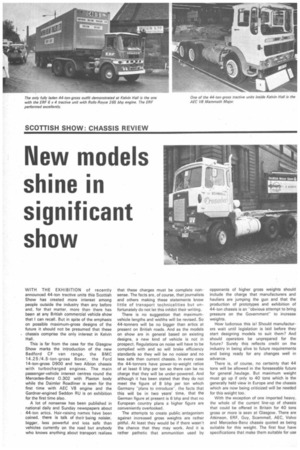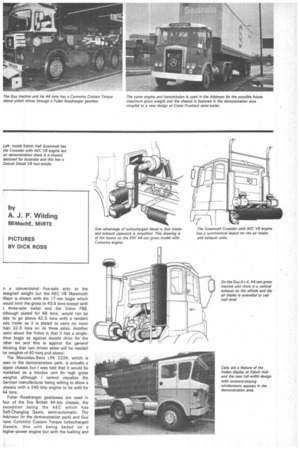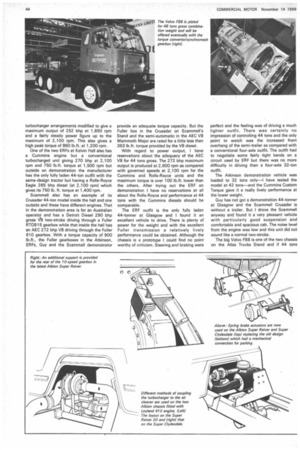New models shine in significant show
Page 44

Page 45

Page 46

Page 47

Page 48

If you've noticed an error in this article please click here to report it so we can fix it.
WITH THE EXHIBITION of recently announced 44-ton tractive units this Scottish Show has created more interest among people outside the industry than any before and, for that matter, more than there has been at any British commercial vehicle show that I can recall. But in spite of the emphasis on possible maximum-gross designs of the future it should not be presumed that these chassis comprise the only interest in Kelvin Hall.
This is far from the case for the Glasgow Show marks the introduction of the new Bedford CF van range, the BMC 14.25 /4.5-ton-gross Boxer, the Ford 14-ton-gross D900 and two Albion chassis with turbocharged engines. The main passenger-vehicle interest centres round the Mercedes-Benz 0.302 with Plaxton body while the Daimler Roadliner is seen for the first time with AEC V8 engine and the Gardner-engined Seddon RU is on exhibition for the first time also, A lot of nonsense has been published in national daily and Sunday newspapers about 44-ton artics. Hair-raising names have been coined, there is talk of their being noisier, bigger, less powerful and less safe than vehicles currently on the road but anybody who knows anything about transport realizes that these charges must be complete nonsense. The facts are, of course, that journalists and others making these statements know little of transport technicalities but unfortunately do not let this inhibit their writing.
There is no suggestion that maximumvehicle lengths and widths will be revised. So 44-tonners will be no bigger than artics at present on British roads. And as the models on show are in general based on existing designs, a new kind of vehicle is not in prospect. Regulations on noise will have to be complied with and so will brake efficiency standards so they will be no noisier and no less safe than current chassis. In every case the 44-tonners have power-to-weight ratios of at least 6 blip per ton so there can be no charge that they will be under-powered. And although it has been stated that they do not meet the figure of 8 bhp per ton which Germany "plans to introduce-, the facts that this will be in two years' time, that the German figure at present is 6 bhp and that no European country plans a higher figure are conveniently overlooked.
The attempts to create public antagonism against increased gross weights are rather pitiful. At least they would be if there wasn't the chance that they may work. And it is rather pathetic that ammunition used by
opponents of higher gross weights should include the charge that manufacturers and hauliers are jumping the gun and that the production of prototypes and exhibition of 44-ton chassis is an -obvious attempt to bring pressure on the Government" to increase weights.
How ludicrous this is! Should manufacturers wait until legislation is laid before they start designing models to suit them? And should operators be unprepared for the future? Surely this reflects credit on the industry in being alive to future requirements and being ready for any changes well in advance.
There is, of course, no certainty that 44 tons will be allowed in the foreseeable future for general , haulage, But maximum weight must go up if only to 40 tons which is the generally held view in Europe and the chassis which are now being criticized will be needed for this weight too.
With the exception of one imported heavy, the whole of the current line-up of chassis that could be offered in Britain for 40 tons gross or more is seen at Glasgow. There are Atkinson, ERF, Guy, Scammell, AEC, Volvo and Mercedes-Benz chassis quoted as being suitable for this weight. The first four. have specifications that make them suitable for use
n a conventional five-axle artic at the iesigned weight but the AEC V8 Mammoth Major is shown with the 17-ton bogie which would limit the gross to 43.5 tons except with 3 three-axle trailer and . the Volvo F88, 31though plated for 48 tons, would not be 3ble to go above 42.5 tons with a tandem 3xle trailer as it is plated to carry no more than 22.5 tons on its three axles. Another joint about the Volvo is that it has a singledrive bogie as against double drive for the Dther six and this is against the general thinking that two driven axles will be needed for weights of 40 tons and above.
The Mercedes-Benz LPK 2224, which is seen in the demonstration park, is actually a tipper chassis but I was told that it would be marketed as a tractive unit for high gross weights although I cannot visualize the German manufacturer being willing to allow a chassis with a 240 bhp engine to be sold for 44 tons.
Fuller Roadranger gearboxes are used in four of the five British 44-ton chassis, the exception being the AEC which has Self-Changing Gears, semi-automatic. The Atkinson (in the demonstration park) and Guy have Cummins Custom Torque turbocharged diesels, this unit being based on a higher-power engine but with the fuelling and turbocharger arrangements modified to give a maximum output of 252 bhp at 1,850 rpm and a fairly steady power figure up to the maximum of 2,100 rpm. This also gives a high peak torque of 860 lb.ft. at 1,200 rpm.
One of the two ERFs at Kelvin Hall also has a Cummins engine but a conventional turbocharged unit giving 270 bhp at 2,100 rpm and 750 lb.ft. torque at 1,500 rpm but outside on demonstration the manufacturer has the only fully laden 44-ton outfit with the same-design tractor but having a Rolls-Royce Eagle 265 bhp diesel (at 2,100 rpm) which gives its 750 lb. ft. torque at 1,400 rpm.
Scammell also has an example of its Crusader 44-ton model inside the hall and one outside and these have different engines. That in the demonstration area is for an Australian operator and has a Detroit Diesel 290 bhp gross Ve two-stroke driving through a Fuller RT0915 gearbox while that inside the hall has an AEC 272 bhp V8 driving through the Fuller 610 gearbox. With a torque capacity of 900 lb.ft., the Fuller gearboxes in the Atkinson, ERFs, Guy and the Scammell demonstrator provide an adequate torque capacity. But the Fuller box in the Crusader on Scammell's Stand and the semi-automatic in the AEC V8 Mammoth Major are rated for a little less than 363 lb .ft. torque provided by the V8 diesel.
With regard to power output, I have reservations about the adequacy of the AEC V8 for 44 tons gross. The 272 bhp maximum output is produced at 2,600 rpm as compared with governed speeds at 2,100 rpm for the Cummins and Rolls-Royce units and the maximum torque is over 100 lb.ft. lower than the others. After trying out the ERF on demonstration I have no reservations at all about the Rolls-Royce and performance at 44 tons with the Cummins diesels should be comparable.
The ERF outfit is the only fully laden 44-tonner at Glasgow and I found it an excellent vehicle to drive. There is plenty of power for the weight and with the excellent Fuller transmission a relatively lively performance could be obtained. Although the chassis is a prototype I could find no point worthy of criticism. Steering and braking were perfect and the feeling was of driving a much lighter outfit. There was certainly no impression of controlling 44 tons and the only point to watch was the increased front overhang of the semi-trailer as compared with a conventional four-axle outfit. The outfit had to negotiate some fairly tight bends on a circuit used by ERF but there was no more difficulty in driving than a four-axle 32-ton outfit.
The Atkinson demonstration vehicle was loaded to 32 tons only—I have tested the model at 42 tans—and the Cummins Custom Torque gave it a really lively performance at the lower weight.
Guy has not got a demonstration 44-tonner at Glasgow and the Scammell Crusader is without a trailer. But I drove the Scammell anyway and found it a very pleasant vehicle with particularly good suspension and comfortable and spacious cab. The noise level from the engine was low and this unit did not sound like a normal two-stroke.
The big Volvo F88 is one of the two chassis on the Ailsa Trucks Stand and if 44 tons
comes the double-drive version is likely to be a major contender. In this connection the new MR61 eight-speed synchromesh gearbox in which the drive goes through a torque convertor has much significance. I tried out this transmission last week (reported in CM November 7} and found it of benefit In boosting the torque from the engine as well as making driving easier. The Volvo has, in any case, adequate performance in standard form as I found first of all two years ago when I drove the model at 42 tons from London to Glasgow.
Two new medium-weight chassis introduced for the Glasgow Show show that the "war" in this section of the market is hotting up. The BMC Boxer is rated for 14.25 tons—or 14.5 tons far special application —whereas the new Ford 0900 has a weight limit of 14 tons. There seems every chance, however, that the Ford will be uprated by 6cwt or so in the not-too-distant future so that it will compete on exactly level terms. Both the chassis follow the Dennis Pax V 15-tonner which is seen in Glasgow in unchanged form, with marketing apparently aimed at selling "payload" rather than "for maximum gross". Loads of close to 9.5 tons should be possible with both models which is not all that much short of what is practicable on a 16-ton-gross machine, particularly when it is difficult to load without exceeding axle-weight limits.
In the van field there is also likely to be a revitalization of competition with the introduction of the Bedford CF range which is available in a range of models comparable to those in the Ford Transit series. One wonders how long it will be before BLMC and Rootes introduce similarly wide ranges of vans to stay in full competition.
Important alterations to existing models have been made by Albion with the introduction of the Leyland 410 turbocharged diesel which gives 155 bhp gross for two of its chassis. The Super Clydesdale tractive unit gets an increase in wheelbase to 9ft 6in, and an increase in gross weight rating from 22 to 24 tons with the use of the new engine but the Super Reiver 20, 6 x 4 tipper retains the same 20-ton weight limit. A gearbox change accompanies the use of the new engine; an AEC six-speed box is standard with a 10-speed range change unit the option. Braking is also altered with spring brake units employed to meet the secondary and parking requirements instead of mechanical handbrake and multi-diaphragm chambers.
The bodywork by Plaxtons on the Mercedes-Benz 0.302 chassis is dealt with in another section of this Scottish Show review. The chassis used as a basis is the standard product of the German manufacturer, specification of the 0.302 including full air suspension, a 185 bhp gross diesel mounted vertically and longitudinally at the rear and five-speed synchromesh transmission. The other two ps.v. models of interest are seen in chassis form, these being the Daimler Roadliner with AEC V8 at the rear and Seddon RU with Gardner 6HLX mounted horizontally at the rear end.
There are only two trailer manufacturers with stands in Kelvin Hall, these being BIC and Northern. One of the W7000 tandem-axle semi-trailers is shown by BIC, this having been announced two weeks ago. It is a
lightweight design with fourspring-and-balance-beam suspension and the 33ft long exhibit which is designed for operation in a 32-ton-gross outfit will probably weigh less than 4 tons although no confirmation of this could be obtained.
The two exhibits by Northern Trailer Co. Ltd. are existing designs but show recent improvements including extra protection for the air brake connections, loops in the electrical wiring near the junction boxes to facilitate servicing and a worm-and-wheel parking brake. The exhibition of a steering axle made by Asse Rigo of Italy was also planned but this had not arrived by the opening day. Northern plans to use the Rigo design instead of Ceschi mainly because of improved flexibility. The design allows twin tyres to be fitted and Northern plans to use it for both tandem and three-axle trailers. In the latter case the firm will use one or two lone in the front and one behind the fixed axle) according to the requirements of the operator.
Two other trailers worthy of note at Kelvin Hall are coupled to demonstration vehicles. The ER F 44-ton model has a skeletal design manufactured by Municipal Trailers Ltd, of Preston—a new name in maximum-gross trailers--while the Atkinson is being demonstrated with a prototype Crane Fruehauf platform /skeletal model specially designed for operation in an outfit at 44 tons gross.




















































































































